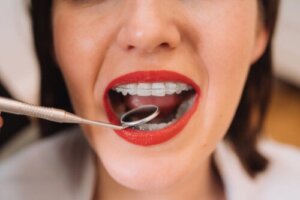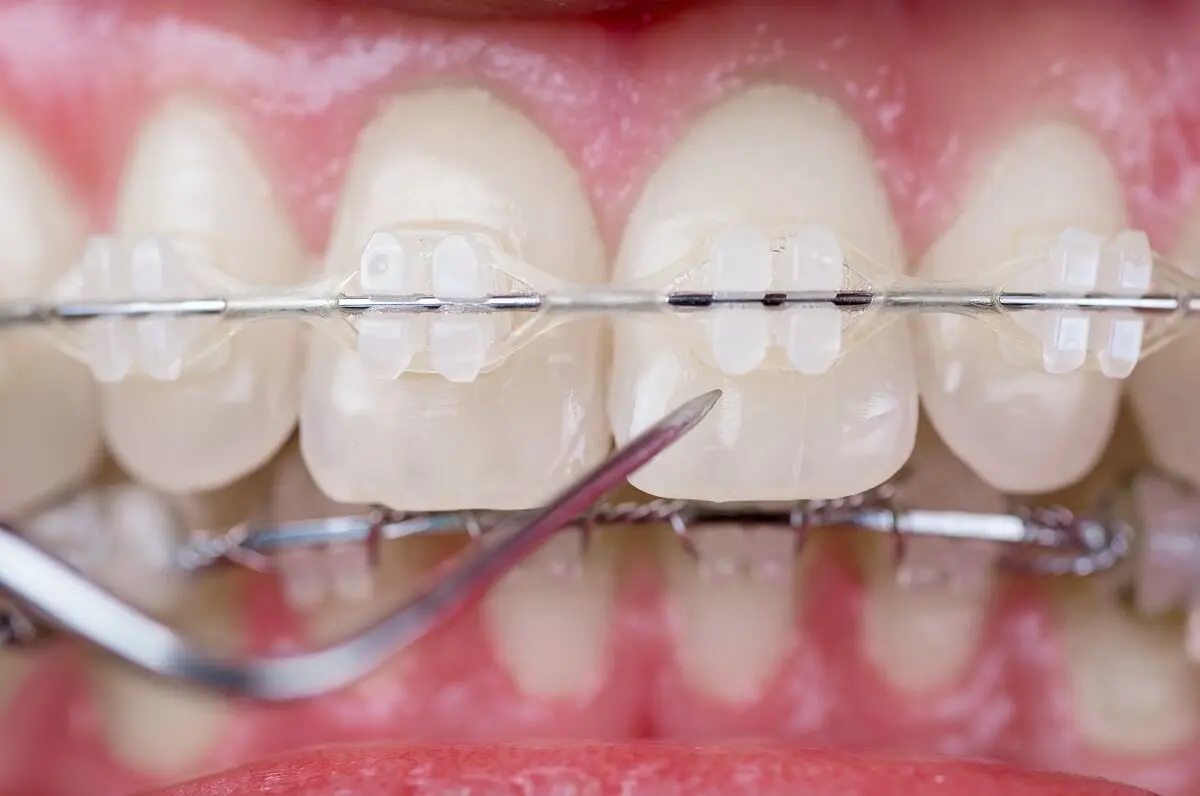Ceramic and Sapphire Braces: The Advantages and Differences


Written and verified by the dentist Vanesa Evangelina Buffa
More and more people are looking for the most esthetic alternatives when it comes to orthodontic treatment. Ceramic and sapphire braces are options that respond very well to this interest in discretion when wearing braces.
Your orthodontist may consider the need for braces to solve bite problems and improve the appearance of the smile. Nowadays, there are multiple therapeutic options capable of accomplishing the same objective. Therefore, when it comes to wearing braces, the classic metal and wires on the teeth are no longer the only ones on the market.
For those who want orthodontics to go unnoticed, there are aesthetic options. Lingual braces, invisible splints, and ceramic and sapphire braces are the most commonly used. These alternatives respond to the different needs of the patient and also to his or her economic possibilities.
It will always be the orthodontist who can best advise you on the correct appliance. In any case, in this article, we’ll take a detailed look at the differences between ceramic and sapphire braces.
Braces and dental esthetics
When it comes to solving problems with biting and repositioning poorly positioned teeth, orthodontics is the treatment of choice. The aim of this therapy is to make the teeth reach their ideal position and achieve a perfectly functional and esthetic mouth.
The use of braces for a period of time allows the correction of alterations such as open or crossbites, overbites, crowding, and diastemas. It also helps to reposition crooked and misplaced teeth.
Orthodontics with metal braces is the most traditional and also the most budget-friend method. However, nowadays, orthodontists have many more alternatives to offer their patients.
The evolution of the therapeutics used allows the patient to choose between various materials that are better adapted to the needs of both your mouth and your wallet:
- Metallic braces: These are the most popular and budget-friendly versions. They’re usually used in young patients.
- Aesthetic braces: These are braces made of ceramic and sapphire.
- Self-ligating braces: This is a method that doesn’t require elastic bands to attach the archwire to the braces.
- Lingual braces: In this case, the braces are placed on the back or inside of the teeth.
- Invisible orthodontics or Invisalign: Instead of braces, removable transparent splints are used.
We think you may also enjoy reading this article: White Spots on the Teeth: Why Do They Appear?
Ceramic braces
Ceramic braces are characterized by being able to mimic the color of the teeth. They have an opaque white or ivory shade that makes them almost imperceptible when smiling.
However, you should know that not all types of ceramic braces are the same. There are various brands with different properties and particularities.
Nowadays, the quality of the material and the design have been optimized. The new advanced ceramic braces are the ones that offer better properties and superior results. This is the type of braces we’re referring to in this article.
This is because the lower-quality ceramics are already falling into disuse because they’ve been surpassed by the improvements brought about by new technology. Ceramic braces made with more obsolete materials are fragile, stain with food and with the passage of time, and don’t adhere properly.
In contrast, the new advanced ceramic braces are small, rounded, and ergonomic. The surface is smooth and they’re cemented without leaving residue. In addition, the chances of breakage and deformation have been minimized due to improvements in strength.
Another improvement is that staining or discoloration during treatment is avoided this way. It also prevents the braces from turning yellow over time, which can affect the aesthetic aspect for which they’re usually used.
This type of brace sometimes even allows the placement of aesthetic archwires and ligatures instead of metal ones. This makes them even more discreet. Plus, if for reasons of mechanical efficiency these components must be metallic, they’re usually very discreet overall.
This type of material is more expensive than conventional metal orthodontics. However, its price is similar to sapphire braces.

The benefits of ceramic braces
We have already mentioned that the ivory color similar to dental enamel is one of the characteristic aspects of this material that can lead people to choose them. They blend in very well with the teeth, often going unnoticed.
However, in addition, advanced ceramic braes offer some technical advantages that allow them to meet the orthodontic needs of patients:
- They don’t leave adhesion residue: They have high adhesion to the teeth and an efficient seal that prevents cavities and leaks. And when they’re removed, no residue is left on the teeth.
- Smaller size: They occupy a smaller dental surface, reducing discomfort on lips, cheeks, and gums.
- A smooth and polished surface improves the patient’s adaptation to the appliance and reduces the possibility of suffering injuries due to rubbing and sores.
- They’re easy and quick to insert and remove.
- Biocompatible: They can be used in patients allergic to metals.
- Resistant: They have a low chance of breaking.
Sapphire braces
Sapphire braces are another aesthetic orthodontic option. They’re characterized by being transparent and have an appearance similar to glass.
This allows the original color of the tooth to be seen underneath, making them almost imperceptible. This crystalline behavior makes it the best esthetic alternative for patients with darker teeth.
Sapphire braces are made with crystals of this material or in its synthetic form. The product has an adequate fixation to the tooth, can’t be altered, doesn’t stain or discolor during treatment, and is sufficiently resistant. Therefore, it’s an excellent option if you’re looking for an esthetic appliance.
The cost of sapphire braces is higher than that of metal braces and similar to optimized ceramic braces.
The advantages of sapphire braces
Sapphire braces, like ceramic braces, have as their main advantage their esthetic appearance. In this case, it’s the transparency of the material that allows them to show the underlying tooth and go unnoticed.
Their transparency is an excellent esthetic option in a wide range of cases. This type of braces work very well on teeth with rare or infrequent colorations, such as grayish and brownish ones.
In addition to esthetics, sapphire has good adhesion to enamel and adequate mechanical retention. It’s difficult and accidental for them to become detached or fall off.
Their small, rounded design and polished finish also allow the patient to adapt well to the appliance. Plus, there’s a lower risk of chafing and mucosal injury.
Another advantage of this material is that it does not stain or pigment. Therefore, even if you smoke, drink tea, coffee or wine as time goes by, the braces won’t change color.
They’re very resistant and difficult to break. However, as with glass, strong impacts or accidental dry blows could cause them to fracture.
The differences between ceramic and sapphire braces: Which one to choose?
Now that we’ve told you about the features and advantages of ceramic and sapphire braces, we can focus on the subtle differences between them. Although both are excellent esthetic options when it comes to wearing braces, there are situations that merit opting for one over the other.
One of the differences between the two materials is their optical behavior and, therefore, the visual perception of the braces on the teeth. Sapphire is translucent, like glass, and it renders the color of the natural tooth underneath transparent. Ceramic is more opaque and has its own ivory color.
Ceramic braces blend in very well with light, whitish teeth without noticeable veining. On the other hand, sapphire braces are a better alternative for teeth with grayish or brownish enamel.
Although both materials are resistant, advanced ceramic braces are preferable in cases with greater mechanical requirements. If torques or auxiliary attachments are to be applied, for example, sapphire may be more fragile and have a higher risk of fracture.
Beyond the differences that we’ve told you about here, it will always be the orthodontist who can best advise each person on the appropriate alternatives for their needs. Depending on the objective of the treatment, the size, color of the teeth, habits, preferences, and possibilities of the patient, the appropriate material will be determined.

How to care for ceramic and sapphire braces?
When it comes to wearing aesthetic orthodontics, there’s some care that you should consider during treatment. Whether the braces are ceramic or sapphire, these are aspects that will help you keep the appliances in optimal condition:
- Tooth brushing: Although ceramic and sapphire braces have smooth and rounded surfaces that retain less bacterial plaque than conventional braces, it’s essential to brush your teeth after every meal. Any foreign body in the mouth favors the retention of debris and germs.
- Use dental floss or interproximal brushes: This allows for cleaning the area between teeth and teeth and prevents the accumulation of bacteria. Dental irrigators are also helpful in removing debris in these hard-to-reach places.
- Use mouthwashes: The use of oral rinses helps to complete dental hygiene and remove food debris and bacteria from the mouth. The dentist may recommend products with fluoride or antiseptics depending on the patient’s needs.
- Be careful with certain types of food: Although sapphire and advanced ceramic braces don’t stain, there are some hard or sticky foods that should be avoided. Biting on very consistent foods can detach or split these attachments. It’s best to avoid nuts, chocolates, and nougat, for example.
Like this article? You may also like to read: How to Remove Tartar From Your Teeth Naturally
Ceramic or sapphire braces for a harmonious smile
Whether the material of the brace is ceramic or sapphire, you can get an optimal result and a harmonious and balanced bite. However, this will depend on the proper diagnosis and treatment plan carried out by the orthodontist.
Braces allow the teeth to be moved to align and reposition them. Meanwhile, the material of the attachment will give it particular qualities and characteristics. Planning the process well is the key to success.
Putting your mouth in the hands of an experienced orthodontist is one of the best strategies when looking for the perfect smile. Thorough studies, an accurate diagnosis, and proper therapeutic planning make the difference in this type of treatment.
Finally, if you’re looking for aesthetic options, now you know that ceramic and sapphire braces are a good option so that the braces go unnoticed. With the information provided here and the advice of your trusted professional, you will be able to choose the best alternative for you.
All cited sources were thoroughly reviewed by our team to ensure their quality, reliability, currency, and validity. The bibliography of this article was considered reliable and of academic or scientific accuracy.
- López, J. D. T., Meraz, W. S., Cárdenas, J. M., Amaro, A. M. G., Cantú, F. J. G., & Murga, H. M. (2015). Evaluación de carga bacteriana en brackets metálicos versus brackets cerámicos. Revista mexicana de ortodoncia, 3(4), 228-232.
- ElSherifa, M. T., Shamaa, M. S., & Montasser, M. A. (2020). Enamel around orthodontic brackets coated with flash-free and conventional adhesives. Zahnschmelz im Bereich von mit flash free und konventionellen Adhäsiven beschichteten kieferorthopädischen Brackets. Journal of orofacial orthopedics = Fortschritte der Kieferorthopadie : Organ/official journal Deutsche Gesellschaft fur Kieferorthopadie, 81(6), 419–426. https://doi.org/10.1007/s00056-020-00241-7
- Pasha, A., Vishwakarma, S., Narayan, A., Vinay, K., Shetty, S. V., & Roy, P. P. (2015). Comparison of Frictional Forces Generated by a New Ceramic Bracket with the Conventional Brackets using Unconventional and Conventional Ligation System and the Self-ligating Brackets: An In Vitro Study. Journal of international oral health : JIOH, 7(9), 108–113.
- Lee, Y. K., & Bin, Y. (2016). Translucency and color match with a shade guide of esthetic brackets with the aid of a spectroradiometer. Dental press journal of orthodontics, 21(2), 81–87. https://doi.org/10.1590/2177-6709.21.2.081-087.oar
- Guignone, B. C., Silva, L. K., Soares, R. V., Akaki, E., Goiato, M. C., Pithon, M. M., & Oliveira, D. D. (2015). Color stability of ceramic brackets immersed in potentially staining solutions. Dental press journal of orthodontics, 20(4), 32–38. https://doi.org/10.1590/2176-9451.20.4.032-038.oar
- Abi Dergham, C., Khoury, E., & Ghoubril, J. (2019). In vitro comparison of frictional forces of a new polycrystalline ceramic bracket versus metal-insert ceramic bracket before and after aging. International Orthodontics, 17(2), 202-207.
- LOPEZ ERENAS, CAROLINA (2016). RESISTENCIA DE LOS BRACKETS DE ZAFIRO A LAS FUERZAS DE COMPRENSION, CIZALLA Y TORSION.
- Riatti, R. Digital Smile Design a 3M™ Clarity™ ADVANCED Keramické Zámky: dokonalá synergie Digital Smile Design and 3M™ Clarity™ ADVANCED Ceramic Brackets: the perfect synergy.
- Cruz Vallejos, Y. Y. (2019). Comparación de la adhesión de streptococcus mutans atcc 25175 sobre la superficie de brackets metálicos, cerámicos, resina y zafiro.
- Yang, L., Yin, G., Liao, X., Yin, X., & Ye, N. (2019). A novel customized ceramic bracket for esthetic orthodontics: in vitro study. Progress in Orthodontics, 20(1), 1-10.
- Villacetín Domínguez, I. G. Evaluación In vitro de la pigmentación en brackets estéticos expuestos a bebidas y condimentos.
This text is provided for informational purposes only and does not replace consultation with a professional. If in doubt, consult your specialist.








